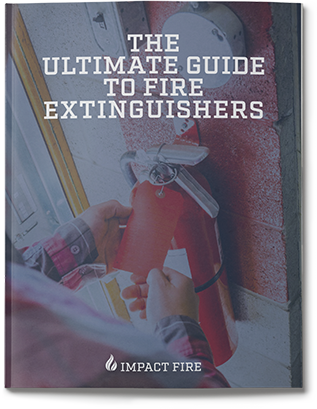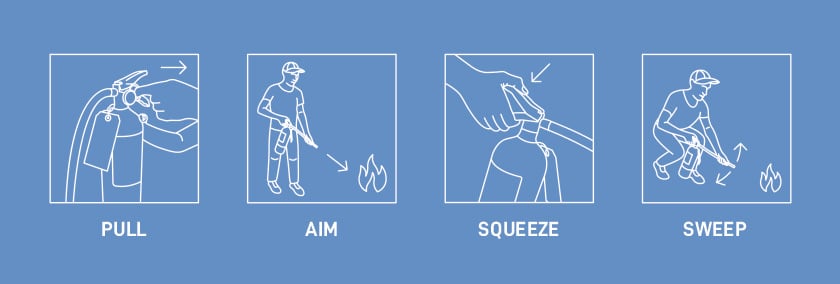It should be no surprise that every commercial and industrial space needs to be equipped with fire extinguishers to arm personnel with life-saving equipment.
But it’s not enough to know this simple point. It’s imperative to understand the different types of fire extinguishers, how to use them, and how to maintain them.

Not a problem! Enter your email below for a downloadable PDF version that you can get to on your own time.
Impact Fire will use your email to send you the PDF guide you've requested, as well as information about Impact Fire products and services that may be of interest to you. You can unsubscribe at any time.
To determine the type of extinguisher needed, it helps to have a basic understanding of the five main Classes of fire that you could encounter.
Many fire extinguishers are labeled with clear pictures indicating what Class the extinguisher is suitable for, while some older versions may only be indicated by the Class letter.
No matter the Class, fires always comprise the same four elements: fuel, heat, oxygen, and chain reaction. Portable fire extinguishers are designed to extinguish a fire by removing one or more of these elements. However, it’s essential to keep in mind that not all fire extinguishers can extinguish all Class of fires, and some may even cause more damage and harm to the operator than help extinguish the flames.
Err on the side of safety and always keep specific extinguishers on hand for likely scenarios, like a Class K extinguisher in a kitchen and Class B in a garage.
Simply knowing the Class of fire and using an appropriate extinguisher is all that is needed to save lives in an emergency where fighting a fire is feasible. Using the incorrect agent can allow the fire to reignite after successfully extinguishing. The next step is choosing a suitable extinguisher for your environment. Different extinguishing agents should be considered to determine the correct fire extinguisher for your specific application.
As denoted by the name, these extinguishers are effective for Class A, B, and C fires, and therefore are standard extinguishers to find in many different environments. Dry chemical fire extinguishers put out the fire by primarily interrupting the chemical reaction of the fire.
These extinguishers use pressurized carbon dioxide (CO2) to remove oxygen from the fire, eliminating an essential element needed for fires to burn. CO2 extinguishers are primarily used in Class B and C fires and require no cleanup.
Specialized for Class K fires, these fire extinguishers use a new agent that extinguishes the fire by removing the heat from the fire and preventing re-ignition by creating a barrier between the oxygen and fuel elements. A wet chemical of Class K extinguishers was developed for modern, high-efficiency deep fat fryers in commercial cooking operations.
These fire extinguishers apply a spray of water, which rapidly lowers the temperature of the fire. Water mist extinguishers are primarily for Class A fires, although they are safe to use on Class C fires.
These extinguishers propel a foam solution that expands when it hits the air, cooling the fire and coating the combustible fuel, creating a barrier from oxygen. Foam extinguishers are suitable for Class A and B fires.
Commonly used on Class B and C fires, clean agent extinguishers utilize gaseous fire suppression - meaning no cleanup - by reducing the oxygen levels near the fire and stopping the chain reaction needed for the fire to continue to burn.
This specialized extinguisher works similarly to dry chemical extinguishers by using a powder to separate oxygen from the fuel. However, these extinguishers are only suitable for Class D or combustible metal fires. They are ineffective on all other Classes of fire.
If you’re unsure about what type of fire extinguisher you need to have available in your workplace, it’s best to consult a company that specializes in fire safety equipment to be sure you’re well prepared.
An incipient stage fire is the first of four stages of fire: incipient, growth, fully developed, and decay. Incipient stage fires have just ignited and can be extinguished with a portable fire extinguisher. Recognizing a fire in this stage provides the best chance at suppression or escape.
Proper use of a fire extinguisher in an emergency is key to extinguishing or containing a fire until emergency services arrive on the scene. To learn how to use a fire extinguisher, follow the steps below.

To avoid trapping yourself in a dangerous situation, make sure to keep your back to an accessible escape route to use should the fire become too large to extinguish or too dangerous. Remember that smoke from a fire - not just the flames - can be hazardous and even deadly. Portable fire extinguishers are effective against small fires, but if the flames are overwhelming, you need to evacuate the building and call 911.
According to the National Fire Protection Association (NFPA), fire extinguishers must be maintained annually and inspected monthly to ensure that they are in good operating condition in case of an emergency. Many companies have trained staff who can perform the monthly inspections, while annual maintenance and functionality testing are best left to a safety technician.
Carbon dioxide and water-based extinguishers need a hydrostatic test every five years. Stored-pressure extinguishers require standardized maintenance every six years, and stored pressure and cartridge-operated extinguishers need a hydrostatic test conducted every 12 years.
Performing monthly inspections is a quick yet crucial process in an organization’s overall health and safety plan. When performing these inspections, a third-party provider will complete the following:
Once the inspection is complete, clean the extinguisher, return it to its hanger, and sign and date the service tag to record the inspection. Additionally, the business should receive a complete report of the inspection explaining any deficiencies and recommending corrective action by recognized codes for care and maintenance.
Fire extinguishers should always be readily accessible and visible in the event of a fire. This means they shouldn’t be blocked by cleaning supplies, tucked in the back of storage closets, or locked away in rooms only certain personnel can access. Here are a few things to keep in mind when deciding where to place fire extinguishers:
Where fire extinguishers should be placed around the workplace depends on the location of potential hazards, the size of the area, and the type of extinguisher.
With this in mind, it’s essential to check the maximum travel distance required by code. This refers to the farthest distance a person should travel before reaching a fire extinguisher and can be determined by the Class of extinguisher and the potential hazard type.
It’s also essential to ensure that fire extinguishers are stored in the proper position and temperature. Though newer extinguishers can be stored on their sides, adequate storage is recommended, including appropriate mounting brackets to keep the extinguisher upright and in easy acces
Most modern extinguishers can be stored in a wide range of temperatures — from about -40° F to 120° F — so temperature likely won’t be an issue. However, in extreme low-temperature conditions, the extinguisher valve or hose could crack, leaving the extinguisher unusable, so be sure not to allow the extinguisher to freeze.
Proper knowledge of how to operate fire extinguishers in the workplace can save lives and company assets in the event of a fire and arm employees with the confidence they need to feel safe. It’s essential to meet that knowledge with regular extinguisher inspections and maintenance and provide the appropriate type of extinguisher for each potential hazard. Combined, these aspects create a protected and prepared workplace.
© Impact Fire Services, LLC | All rights reserved
© 2025 IMPACT FIRE SERVICES, LLC
All Rights Reserved